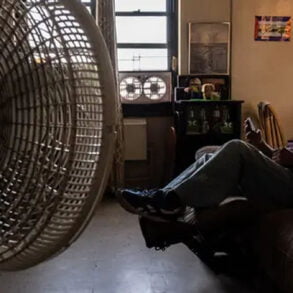
For someone who was famously averse to publicity and whose work is often eclipsed in popular consciousness by being “that one guy in that one movie” — a tall, dark, and stoic Wallace Shawn — actor and playwright Sam Shepard lives on in a mountain of copy. In True West: Sam Shepard’s Life, Work, and Times, Robert Greenfield has scaled the mountain only to add another layer to it, with little promise of being able to distinguish it from all the layers below.

It’s perhaps not very encouraging when the most revealing part of a biography is its works cited section. On the surface, the 10 pages of sources that Greenfield appends to his survey of Sam Shepard commend his diligence in research and his ability to weave that research into an overarching and coherent document of existence, something that was not always present in Shepard’s plays. But consider it more deeply, examining the extensive press clippings (not just reviews but scores of feature profiles in major magazines), critical studies (Shepard has earned a Cambridge Companion), three documentary films, and three previous biographies between 1986 and 2017. Set that against a comparatively paltry list of interviewees (no Jessica Lange or Patti Smith, for instance), and it leaves, at best, a more perplexing impression.
That a famous life, even one that ended only six years before, should be so copiously documented is not itself unusual. But it does reframe, at least much more consciously, the nature of the biography in question toward something approaching a creative project. Given Greenfield’s previous works on Jerry Garcia and Timothy Leary, it would appear at first that True West is one part of his larger ambition to carve, in words, a boomer Mount Rushmore. But something more intricate and complementary to Shepard’s own thematic preoccupations does make itself known, starting with Greenfield’s choice of title.
Greenfield makes good use of Shepard’s play titles throughout his chapters, a wise choice as his titles (The Unseen Hand, The Tooth of Crime, Curse of the Starving Class, Operation Sidewinder, and Forensic and the Navigators) are enviable. True West is a special case. The 1980 play centers on two brothers, a successful screenwriter housesitting for their mother and a petty criminal who drops in from the desert. Across two acts and nine scenes, the two brothers engage in a battle of wits and wills that causes them to switch personas and trash their mother’s suburban home. An ostensibly realist play all the way up to its enigmatic ending where the brothers are “caught in a vast, desert-like landscape” amid a wailing coyote, Greenfield sees it as a portrayal of Shepard’s “dual nature.” “I know I’ve got two sides in me,” Shepard wrote. “One’s totally undisciplined & just wants to wander into some adventure … and the other side has this image of an orderly disciplined life.”
A similar dual nature manifests in Greenfield’s True West. On the one hand, there is the adventurer, a kind of postmodern Horatio Alger hero, weaned on rock ‘n’ roll and Kerouac, escaping from a dysfunctional family in the Southern California desert to a White Castle in Times Square where he needs to donate blood to pay for a burger. From there, he situated himself in the Lower East Side counterculture, dabbling in rock drumming but falling instead into drama. Through sheer talent and his Marlboro ad looks, he crosses paths with almost every icon of the mid-20th century: affairs with Patti Smith and Joni Mitchell, failed collaborations with the Rolling Stones and Bob Dylan, starring roles in Days of Heaven and The Right Stuff.
This side of the Shepard duality runs in near-perfect sync with the madness of his times. His familial background as the son of a B-24 pilot whose multigenerational alcoholism and philandering would haunt Shepard’s work. So would his own romantic life, tending to involve an overlapping wife and lover, who would then become a wife herself. There are incidents of accidental trips with LSD-laced orange sherbet, getting out of conscription by faking insanity, and then an almost seamless drift into acting work that earns him both a stable income and an Academy Award nomination. It is the American boomer arc encapsulated: sex, drugs, draft dodging, and institutional validation.
Tandem with that, however, is the craftsman, since he was writing meanwhile. Through tireless, largely unsupervised trial and error, he became a master of American drama. Early anti-narrative “happenings” with a strong Beckett influence are often written in a day and without revision. Edward Albee rather awkwardly judges that the almost parodically Albee-esque Icarus’s Mother “gives the impression of being a mess.” But under the added influence of Eugene O’Neill and Sophocles, Shepard rifles more confidently through theater’s toolkit — alcoholism, economic plight, the illogic of love, fate, incest. And he starts to forge some visual and linguistic tools of his own. His plays are set in motel rooms and depressed farms; some require cars to be brought onstage. Chicken beheadings were simulated for his early two-act play La Turista, starring a young Sam Waterston. He channeled his deferred rock star ambitions with semi-musicals The Tooth of Crime and Back Bog Beast Bait. His flair for improvised, colloquial speech led Hilton Als to dub him, alongside Amiri Baraka, “the nation’s first hip-hop playwright,” though perhaps closer to the more neglected flyover hip-hop of Esham and the Geto Boys.
In Sam Shepard, Robert Greenfield has a crystallized hero’s journey: The individual talent brought out of the desert to wrestle with and overcome the chaos of its time. Shepard’s work, Greenfield concludes, can “inspire others to create something of equal magnitude, thereby continuing the unbroken chain of artistic achievement that links us all to the past in a timeless manner.” But in 2023, the truce between theater and pop culture initiated by Shepard has become a subservience to pop culture. Popular plays are indistinguishable from amusement park rides when they’re not pipelines for television gigs. The linguistic anarchy of social media makes Shepard’s wordplay seem quaint today; and his hypermasculine rock ‘n’ roll aesthetics are retrograde. Moreover, the American idiom remains a hostage to the minimalist lacerations of David Mamet and Neil LaBute, making Shepard’s successors Tracy Letts and Will Arbery seem provincial by comparison.
Original Article: https://www.washingtonexaminer.com/opinion/how-to-carve-a-boomer-mount-rushmore



